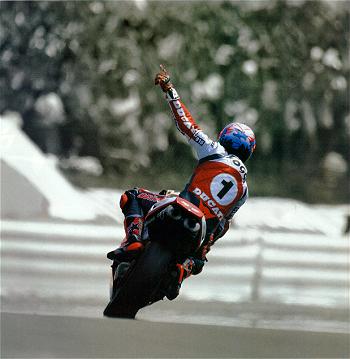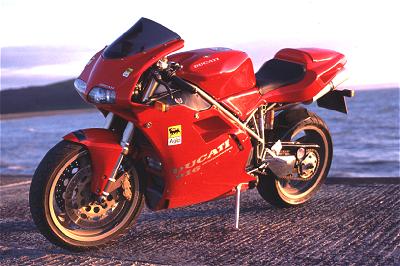DUCATI 916

Advert for well known UK Ducati store, late 90s
This bike caused a sensation when it first appeared in 1994. People stopped and stared, and such was the demand for it that a registered secondhand machine could be sold for more than the new list price. Its function as a pure race machine was never in doubt, though its striking looks meant it became the most desirable machine of the decade. Even now, six years later, only the MV Augusta 750cc could claim to compete in looks.

John Reynolds, 1997 British Superbikes Click image for larger version |

Ducati 916 (955cc) © Simon J Evans
Fast forward to the Summer of 2001, and where is the now venerable Ducati? "Still at the top" is the clear reply. Troy Bayliss won the World Superbike championship, while Ben Bostrom and Neil Hodgson are riding the wheels off their bikes not far behind. Bayliss and Bostrom had the benefit of that year's works bikes, which feature the new 'Testastretta' 998cc engine, while Hodgson is showing his true potential on a year-old machine, riding for the GSE Racing team.
In the UK Superbike series two Ducati-mounted riders slugged it out while the rest of the field appeared to ride around at a lesser pace. Steve Hislop and John Reynolds, both veteran riders with world-class experience, made mincemeat of lap records and wining races by embarassing margins. It doesn't say a lot for the young talent in the domestic superbike class if two riders who one might argue should be "past their best" are making it a two-rider, one-make closed shop. To their credit, they are both great riders. Hislop particularly excels when provided with a team which provides the right technical support, and when the machine works with him is one of the fastest four-stroke riders in the world. Reynolds is a tough cookie who has raced with the best and is prepared to fight to the last to win. Reynolds took the title after Hislop was unable to compete due to an injury.
2002
The following year World Superbikes was a two-man race between Troy Bayliss (Ducati) and Colin Edwards (Honda SP-2). Only Neil Hodgson's year-old customer Ducati got anywhere near these two, as they consistently powered away race after race. The Ducati appeared to have a clear advantage earlier in the season, but Edwards received new parts after the Suzuka 8-hour and went on a winning spree that saw him claw back the points gap and eventually take the title.The UK competition for 2002 looked like it would be the continuation of the previous year. However, Reynolds' Suzuki GSX-R1000, which had proved unbeatable in endurance racing, was undeveloped and failed to provide good competition. Hislop continued with Ducati, determined that this would be his year. Sean Emmett, on a year-old Ducati, provided the strongest challenge, but his title hopes were dashed when his team folded mid-season due to lack of cash from the sponsors. Emmett switched to a Yamaha R1 and rode hard, but the bike was no match for Hizzy's immaculately prepared Ducati 998. Hislop took the title, the first time he had done so since 1995 (he was on a Ducati that year too).
2003
Ducati have developed a new 999cc v-twin for 2003. The 916/996 machine will not be replaced, this motorcycling icon will continue to be sold for a little while yet. However, the future of World Superbikes is a grey area, as no-one knows whether it can run alongside another four-stroke World Championship series (see below). Yamaha and Kawasaki withdrew from World Superbikes, both claiming their 750cc are no longer competitive against the twins of Ducati, Honda and Aprila.For 2003 the WSB rules allow 1000cc four cylinder machines into the class, as the British Superbike series did in 2002. To prevent the playing field tipping back the other way the World Superbike rules required air intake restrictors on all machines, the size varying with the number of cylinders. Neil Hodgson returned to the factory Ducati team and rode the new 999 to victory.
MotoGP and the Desmosedici
The company is now a potent force in the four-stroke Grand Prix class, where prototype machines (i.e. not based on showroom models) of up to 990cc are used. Therefore it seems the most interesting place for Ducati right now is Grand Prix. There is much more about this, including race coverage, on the MotoGP page.Meanwhile World Superbikes in 2004 is providing an interesting season. Admittedly, one dominated by Ducati with the withdrawal of other factories, but with no shortage of talented riders. Meanwhile the British Superbike championship is reckoned to be the hottest domestic Superbike competition around (or is it just us Limeys/Poms who say that?). In WSB the Fireblade is providing the hottest competition, although the Rizla Suzukis are also on the pace in the UK.
Check the race dates for MotoGP, WSB (SBK) and BSB with our calendar.
Relevant links